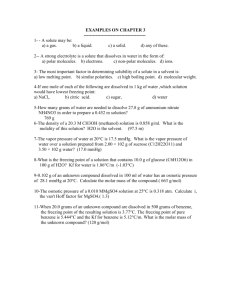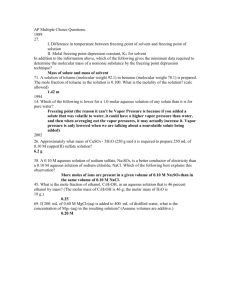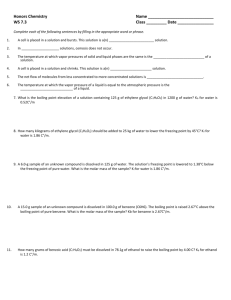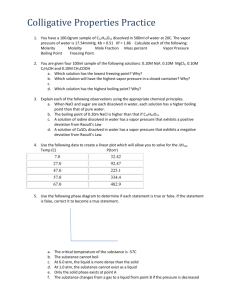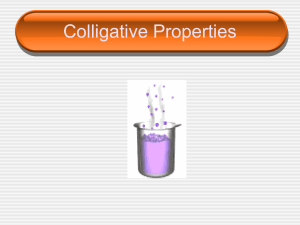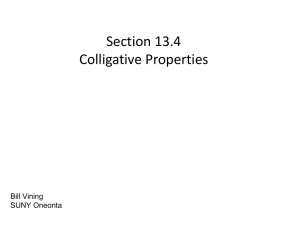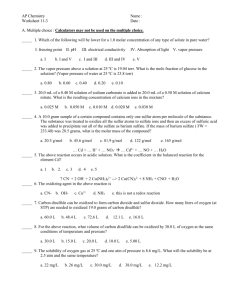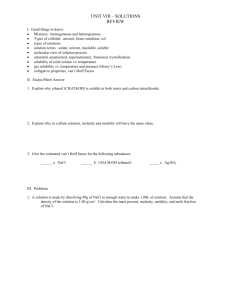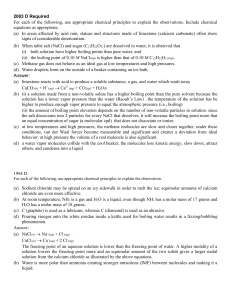Document
advertisement
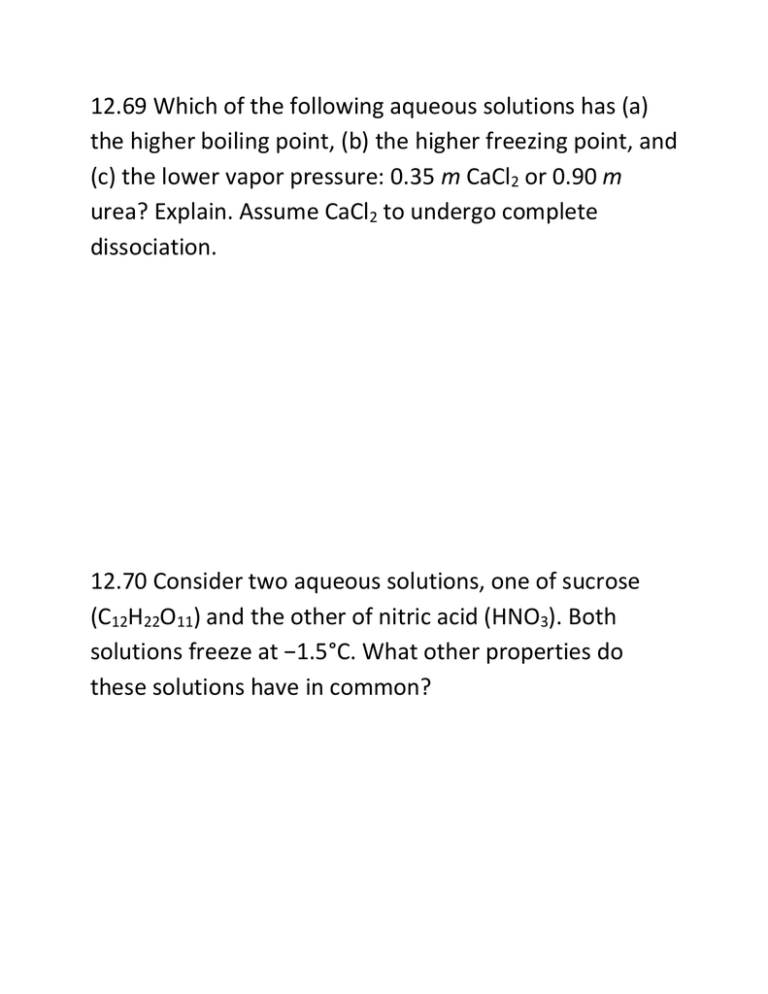
12.69 Which of the following aqueous solutions has (a) the higher boiling point, (b) the higher freezing point, and (c) the lower vapor pressure: 0.35 m CaCl2 or 0.90 m urea? Explain. Assume CaCl2 to undergo complete dissociation. 12.70 Consider two aqueous solutions, one of sucrose (C12H22O11) and the other of nitric acid (HNO3). Both solutions freeze at −1.5°C. What other properties do these solutions have in common? 12.71 Arrange the following solutions in order of decreasing freezing point: 0.10 m Na3PO4, 0.35 m NaCl, 0.20 m MgCl2, 0.15 m C6H12O6, 0.15 m CH3COOH. 12.72 Arrange the following aqueous solutions in order of decreasing freezing point, and explain your reasoning: 0.50 m HCl, 0.50 m glucose, 0.50 m acetic acid. 12.73 What are the normal freezing points and boiling points of the following solutions? (a) 21.2 g NaCl in 135 mL of water and (b) 15.4 g of urea in 66.7 mL of water 12.74 At 25°C the vapor pressure of pure water is 23.76 mmHg and that of seawater is 22.98 mmHg. Assuming that seawater contains only NaCl, estimate its molal concentration. 12.75 Both NaCl and CaCl2 are used to melt ice on roads and sidewalks in winter. What advantages do these substances have over sucrose or urea in lowering the freezing point of water? 12.76 A 0.86 percent by mass solution of NaCl is called “physiological saline” because its osmotic pressure is equal to that of the solution in blood cells. Calculate the osmotic pressure of this solution at normal body temperature (37°C). Note that the density of the saline solution is 1.005 g/mL. 12.82 Water and methanol are miscible with each other but they are immiscible with octane (C8H18). Which of the following shows the correct picture when equal volumes of these three liquids are mixed in a test tube at 20°C? Assume volumes to be additive. (The densities of the liquids are methanol: 0.792 g/mL; octane: 0.703 g/mL; water: 0.998 g/mL.) 12.83 Lysozyme is an enzyme that cleaves bacterial cell walls. A sample of lysozyme extracted from egg white has a molar mass of 13,930 g. A quantity of 0.100 g of this enzyme is dissolved in 150 g of water at 25°C. Calculate the vapor-pressure lowering, the depression in freezing point, the elevation in boiling point, and the osmotic pressure of this solution. (The vapor pressure of water at 25°C is 23.76 mmHg.) 12.84 Solutions A and B have osmotic pressures of 2.4 atm and 4.6 atm, respectively, at a certain temperature. What is the osmotic pressure of a solution prepared by mixing equal volumes of A and B at the same temperature? 12.85 A cucumber placed in concentrated brine (salt water) shrivels into a pickle. Explain. 12.86 Two liquids A and B have vapor pressures of 76 mmHg and 132 mmHg, respectively, at 25°C. What is the total vapor pressure of the ideal solution made up of (a) 1.00 mole of A and 1.00 mole of B and (b) 2.00 moles of A and 5.00 moles of B? 12.87 Calculate the van't Hoff factor of Na3PO4 in a 0.40 m solution whose freezing point is −2.6°C. 12.88 A 262-mL sample of a sugar solution containing 1.22 g of the sugar has an osmotic pressure of 30.3 mmHg at 35°C. What is the molar mass of the sugar? 12.89 An aqueous solution of a 0.10 M monoprotic acid HA has an osmotic pressure of 3.22 atm at 25°C. What is the percent ionization of the acid at this concentration? 12.90 Calculate the mass of naphthalene (C10H8) that must be added to 250 g of benzene (C6H6) to give a solution with a freezing point 2.00°C below that of pure benzene.
